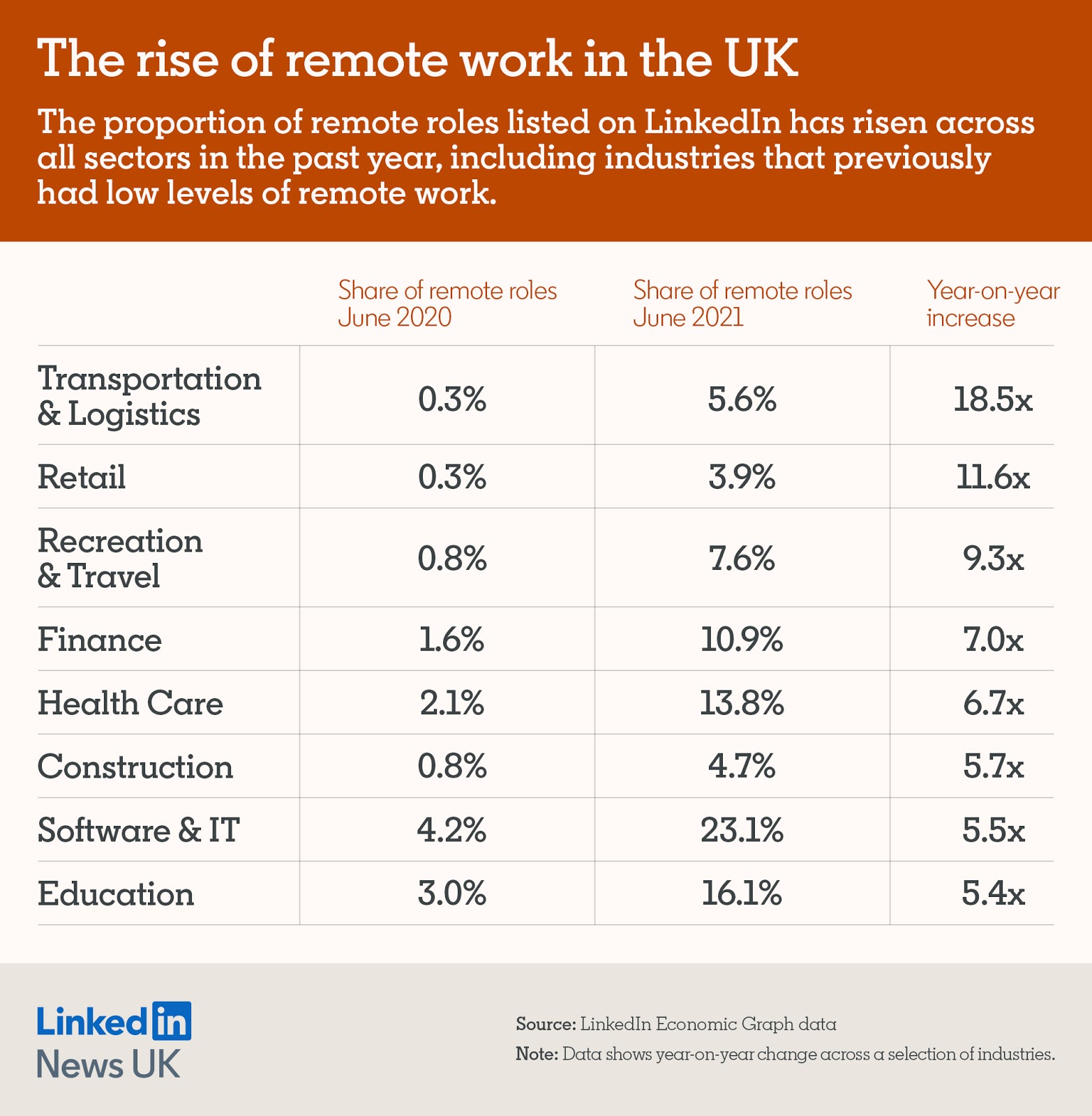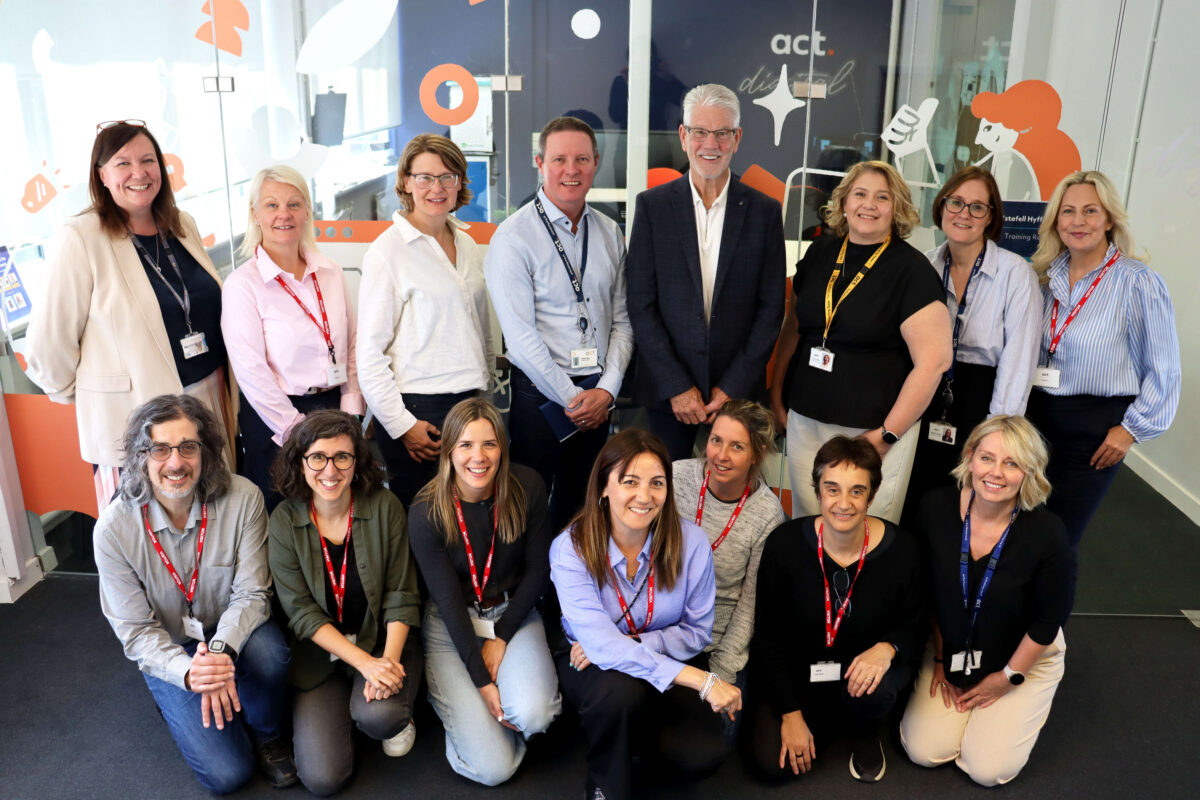Remote job postings boom revealed by LinkedIn’s UK Workforce Report

The impact a remote model will have on the #FutureOfWork
As the latest ONS stats today find UK hiring is surging, new data from LinkedIn’s UK Workforce Report shows that a large share of these new roles are in remote jobs – with different industries showing 3 to 19 times the levels seen in June 2020 as the nation embraces the flexibility of working from home long-term.
Significantly, even industries that had low levels of remote jobs one year ago, such as Retail and Transportation and Logistics, experienced double-digit increases in remote job postings advertised on the platform.
- Remote job adverts soar as UK hiring rates bounce back to 2019 levels
- The share of remote jobs by industry ranges from 3 to 19 times the levels seen in June 2020, as the nation embraces greater flexibility
- Industries that had low levels of remote jobs one year ago, such as Retail and Transportation & Logistics, experienced double-digit increases of 11.6X and 18.5X respectively
- LinkedIn data shows that the UK is seeing a hiring boom, with hiring in June 2021 up 15.5% on June 2019
Despite the end of restrictions and the widespread return to the office in sight, remote job opportunities are still on the rise according to new data from LinkedIn, the world’s largest professional network.
LinkedIn’s UK Workforce Report shows that the share of remote job postings advertised on the platform has increased substantially across all industries, with some sectors recording 3 to 19 times the level of remote job postings compared to June 2020.
Additional research from LinkedIn finds that 38% of UK workers would prefer to work remotely full-time in the future, while 49% prefer hybrid working, and 12% want to work full-time from the office.
Industries that already had a relatively higher share of remote jobs in June 2020, such as Software & IT and Corporate Services, continue to invest in remote positions, seeing an increase ranging from 5.5X to 6.5X. The Software & IT sector in particular appears to be embracing remote work long-term, with more than one in five jobs advertised in June 2021 as remote positions. For industries like Healthcare, Finance, Hardware & Networking and Legal, one in ten advertised positions last month were for remote posts.
Significantly, the trend for remote work has also transformed industries where remote work was previously thought to be impossible to adopt. Sectors with low levels of remote jobs one year ago, such as Retail and Transportation & Logistics, experienced double-digit increases of 11.6X and 18.5X respectively as the pandemic forced businesses to adapt. Though it is still possible some remote jobs may revert back to in-person roles in the future as firms adjust long-term.

Hiring rate on the rise as UK recovery sets in
The rise in remote opportunities comes at a time of strong growth in hiring rates across the UK. LinkedIn’s Workforce Report reveals that hiring rates are steadily rising, up 15.5% in June 2021 compared with June 2019. All industries apart from Energy and Mining are meeting or exceeding pre-pandemic hiring rates – showing strong growth as the country’s recovery continues.
The data shows that jobs in sectors that rely on in-person interaction are starting to bounce back now restrictions are set to lift following a tough year. The Recreation & Travel Sector has seen a 11.9% uplift in hiring compared to June 2019, as Brits look forward to booking summer holidays, with the Retail (19.9%) and Education sector (11.6%) seeing a similar rise. Construction has also seen a strong bounce of 27.4% compared to June 2019, as demand remains high for work. While it will take time for the labour market to fully recover the losses experienced since the pandemic started, recent hiring trends suggest that the UK’s labour market is headed in the right direction.
“It is great that we’re seeing an increase in remote roles that are being posted on our platform. Over the past year, many businesses have had to adapt to a fully remote model, which has been hard for some but has opened the doors to talent outside of the local area and to individuals who previously could not make it into an office.
“Companies are now listening to the needs of their current and potential employees and considering new talent from areas and backgrounds that they previously had to dismiss. This will not only help businesses, but will also provide opportunities to many who haven’t had them before.”
Jannine Chamberlin, UK Country Manager at LinkedIn
Methodology: LinkedIn analysed paid job postings open in June 2020 and June 2021 in the UK. A “remote job” is defined as one where either the job poster explicitly labeled it as “remote” or if the job contained keywords like “work from home” in the listing.
An additional study of 2,014 professionals in the UK was also referenced which was conducted by Censuswide for LinkedIn on 16th June 2021 to understand where people want to work in the future. Censuswide abide by and employ members of the Market Research Society which is based on the ESOMAR principles.
The LinkedIn Hiring Rate (LHR) is the count of hires (LinkedIn members in each industry who added a new employer to their profile in the same month the new job began), divided by the total number of LinkedIn members in the U.K. By only analysing the timeliest data, we can make accurate month-to-month comparisons and account for any potential lags in members updating their profiles.











Responses